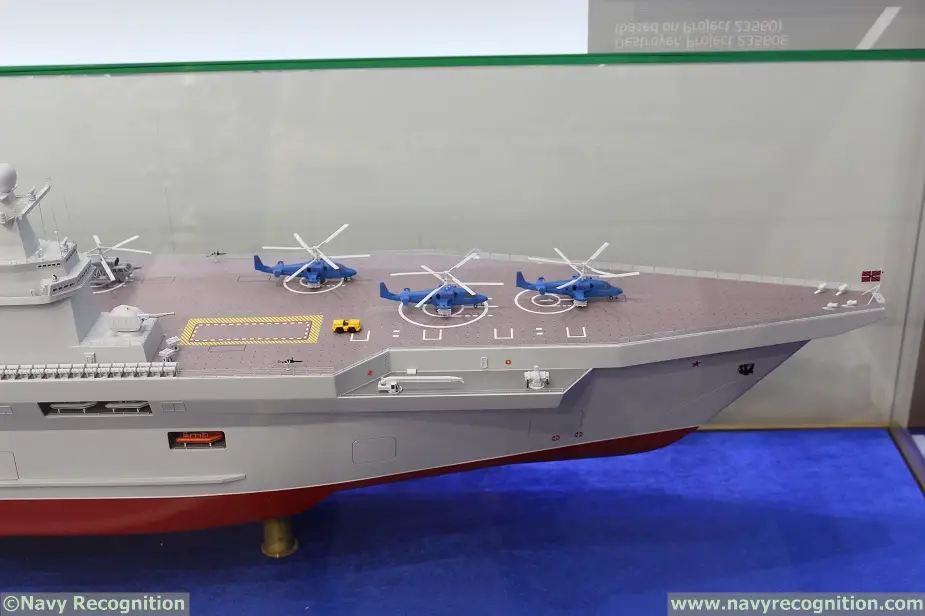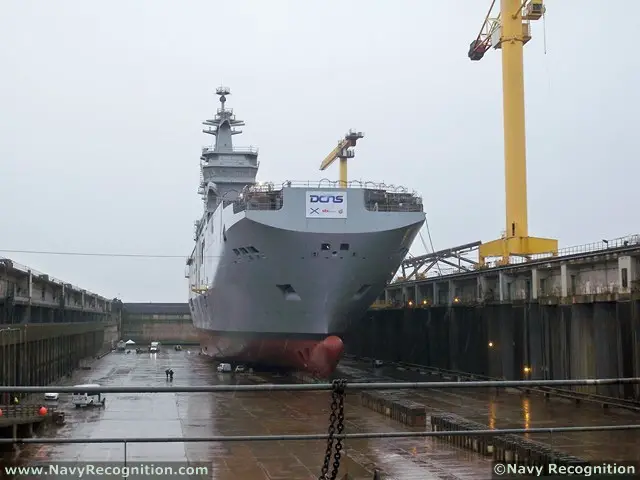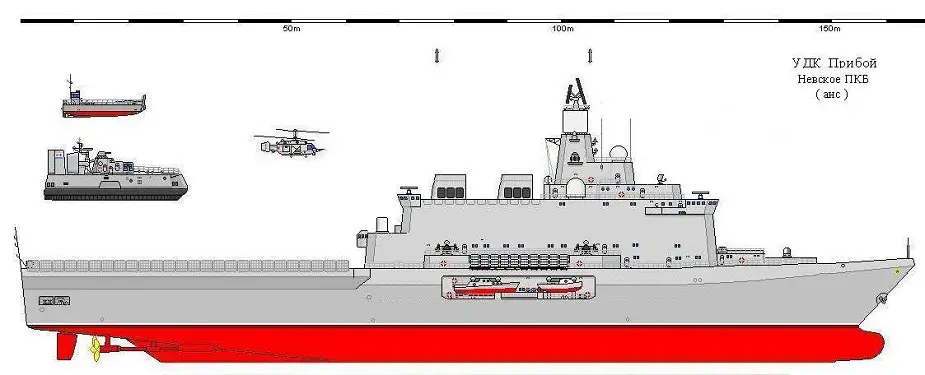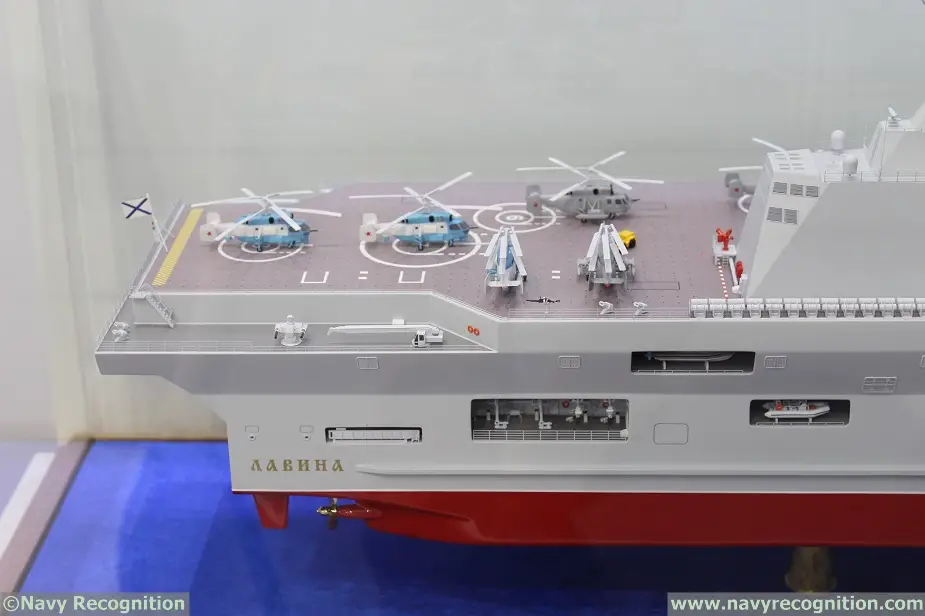Russia Forging Ahead with Universal Landing Ship / Amphibious Vessels Plans
The construction of the first domestic universal landing ship for the Russian Navy is to begin in St. Petersburg in 2020, sources in the defense complex told TASS. The Izvestia daily writes about the prospects of the new warship class and the consequences of the decision to build it.
 Priboy LHD scale model showcased by Krylov during Army 2016 exhibition.
Priboy LHD scale model showcased by Krylov during Army 2016 exhibition.
Yet in the 1980s the Russian leadership realized the necessity to have universal landing ships as the nucleus of expedition forces to land seaborne assault at major distances from naval bases (also outside the range of coastal aviation). Project 11780 had to produce the first Soviet landing ships. The General Headquarters rather than the Navy main command were the main lobbyist of the project. An instrument was necessary to use force in pushing the Soviet interests to remote areas even if there were no friendly countries or pro-Soviet armed movements and organizations. The characteristics and equipment of project 11780 allowed engaging the universal landing ships as command vessels and within strike forces in antisubmarine operations.
The Soviet collapse stopped the project which was to be implemented by the Nikolayev shipyard on the Black Sea and the Russian Navy had to drop altogether for a long time any presence in remote ocean areas. The situation began to change in mid-2000s when economic growth allowed obtaining the necessary political instruments. As the Russian economy was still ailing it was decided to declare a tender for foreign bidders.
 Launch of the first Mistral-class LHD originaly intended for the Russian Navy (then called Vladivostok).
Launch of the first Mistral-class LHD originaly intended for the Russian Navy (then called Vladivostok).
According to available information, the Russian Navy leadership was mostly interested in Korean Dokdo-class amphibious assault ship and the Rotterdam Landing Platform Dock (LPD) amphibious warfare ship of the Royal Netherlands Navy. They were followed by the Spanish Juan Carlos I multi-purpose amphibious assault ship which was used to build Canberra-class landing ships for the Australian Navy.
However, the French Mistral was chosen for political reasons. The initial contract to buy four warships, two of which had to be built in France with Russian participation and the other two in Russia, boiled down to two ships worth a total of 1.15 bln euro with technology transfer, crew training and supplies of additional equipment, including landing boats.
The fate of the deal is well-known. The Ukrainian crisis in 2014 made France abandon the contract. The warships were handed over to Egypt which bought Russian helicopters and equipment for them. The Russian budget got a compensation of close to 1.2 bln euro.
 Russia is currently designing an LPD with a displacement of nearly 14,000 tons. Image for illustration purpose only via shipbucket.
Russia is currently designing an LPD with a displacement of nearly 14,000 tons. Image for illustration purpose only via shipbucket.
The foiled Mistral deal did not kill the interest of the Russian military leadership in the warships of the class. The talk about domestically-built landing ships began right after it became clear that France will not fulfil the contract. It is known today that Russia is designing two concepts of the warships. One of them suggests creating Rotterdam-type landing platform dock with a displacement of nearly 14 thousand tons, six helicopters and a dock-chamber for 2-4 landing boats. Such a ship has to carry and land a 500-men strong battalion of marines with hardware and arms.
The second concept calls for the construction of classical landing ship with aircraft-carrying architecture and bow-to-stern through runway deck, and a displacement of close to 24 thousand tons. It will have a bigger airpower of 20 helicopters to implement the strategy of rapid over-the-horizon two-wave landing with the delivery of hardware, heavy arms and one part of the personnel by landing boats and the other part with light arms by air. The landing force onboard the warship can exceed 900 men.
Both concepts allow engaging the universal landing ships as command vessels, antisubmarine warfare ships and floating bases for humanitarian and rescue operations and other missions. Sources in the Defense Ministry said the navy needs 6-8 such warships at best and four at minimum.
So far the series is limited by two ships.
 Priboy LHD scale model showcased by Krylov during Army 2016 exhibition.
Priboy LHD scale model showcased by Krylov during Army 2016 exhibition.
"For warships will allow permanently keeping one helicopter carrier at sea and another one in rapid reaction standby. The third one will be ready for combat duty in several weeks and the fourth one will be undergoing long-term maintenance or modernization. Six-eight warships will be able to timely rotate and reinforce capacities where they are necessary," the source of the daily said.
Two warships will not make it possible to be permanently present in the necessary areas but will form the nucleus of expeditionary forces to operate at remote theaters of warfare if necessary.
So far Russia has no serial helicopters of the necessary class while available Ka-27 and their modifications, including combat-transport Ka-29, do not suit the needs of the naval aviation. They are a family of medium helicopters for engagement from helipads of warships. Their capabilities are limited in all spheres. Heavier craft capable of carrying over a platoon of soldiers, like the European EH-101, US MH-47 and CH-53 are necessary to fully use the capabilities of big landing ships.
The Russian Helicopters Holding is designing a new family of seaborne helicopters under the Minoga codename however their characteristics are not disclosed. Fire support to the landing force has to be provided by Ka-52K helicopters, a seaborne option of the well-known army aviation rotorcraft.
 Priboy LHD scale model showcased by Krylov during Army 2016 exhibition.
Priboy LHD scale model showcased by Krylov during Army 2016 exhibition.
TASS sources said the Severnaya verf (Northern shipyard) in St. Petersburg will build the universal landing ships. The cost will depend on the project to be chosen. Anyway, the ships will not be too expensive. The price of the French Mistral corresponds to guided missile frigates although the latter have a much smaller displacement. It is due to a high share of guided missiles and radio-electronic equipment in the cost of the warships. A landing ship has fewer costly systems as it is intended to deliver seaborne assault and is armed with short-range air defense and antisubmarine weapons.
Depending on the chosen project - either 14000-ton platform dock or 24000-ton amphibious assault ship - the cost of the lead ship will range from 30 to 50 bln rubles. The construction of the lead ship is to begin in 2020 and the fleet will receive it in 2024. The second warship is to be commissioned in 2026.
Naturally, the airpower will add 20 bln rubles to the cost, but the landing ships will anyway remain a relatively cheap instrument of force. The two planned warships for the Russian Navy can be provided with the necessary escort even without increasing the construction of ordinary warships.
At the same time the Navy is likely postponing the nuclear destroyer project which, according to TASS sources, have to be built by the same Northern shipyard. The rejection of the project is reasonable in the current economic situation. An alternative is the continued construction of project 22350 frigates and bigger upgraded options of project 22350M. As the industry has already mastered the equipment for new frigates, their construction in the necessary volume will strengthen the navy more reliably than the launch of a new project.
As for the universal landing ships, "their construction has to provide the necessary experience to the industry which will in future produce larger ships, including aircraft carriers," the Izvestia said.
© Copyright 2018 TASS. All rights reserved. This material may not be published, broadcast, rewritten or redistributed.
Comment by Navy Recognition: About the Priboy LHD
Russian Krylov State Research Center has developed the Priboy LHD on its own initiative. It is significantly different from the Mistral landing helicopter dock designed by DCNS. Priboy is intended for seaborne movement of troops and military equipment and landing on beaches during amphibious operation in conjunction with other naval forces. It can support projection of soldiers and hardware, take part in offensive mining actions and mount sonar beacons of suspended array surveillance systems.
The Priboy ship has a displacement of 23,000 tones, a length of 200 meters, a width of 34 meters, a designed draught of 7.5 meters, a full speed of 20 knots, a cruising speed of 14 knots, an endurance of 6,000 miles and a cruising capacity of 30 days.
The ship can withstand storms of force 6-7 on the Beaufort scale (strong breeze/near gale).
The helicopter carrier is planned to be equipped with a gas-turbine main propulsion plant. The ship’s crew totals about 400. The vessel can transport 500-900 marines, about 50 infantry fighting vehicles and up to 10 tanks.
Up to 12 military transport and search and rescue helicopters can be based on the Priboy ship. It can also carry six landing boats with a cargo-carrying capacity of 45 tons and six assault boats on davits.
The Priboy's armament suite includes two anti-air gun-missile combat modules, two close-in weapon systems and one 76mm naval gun.


























